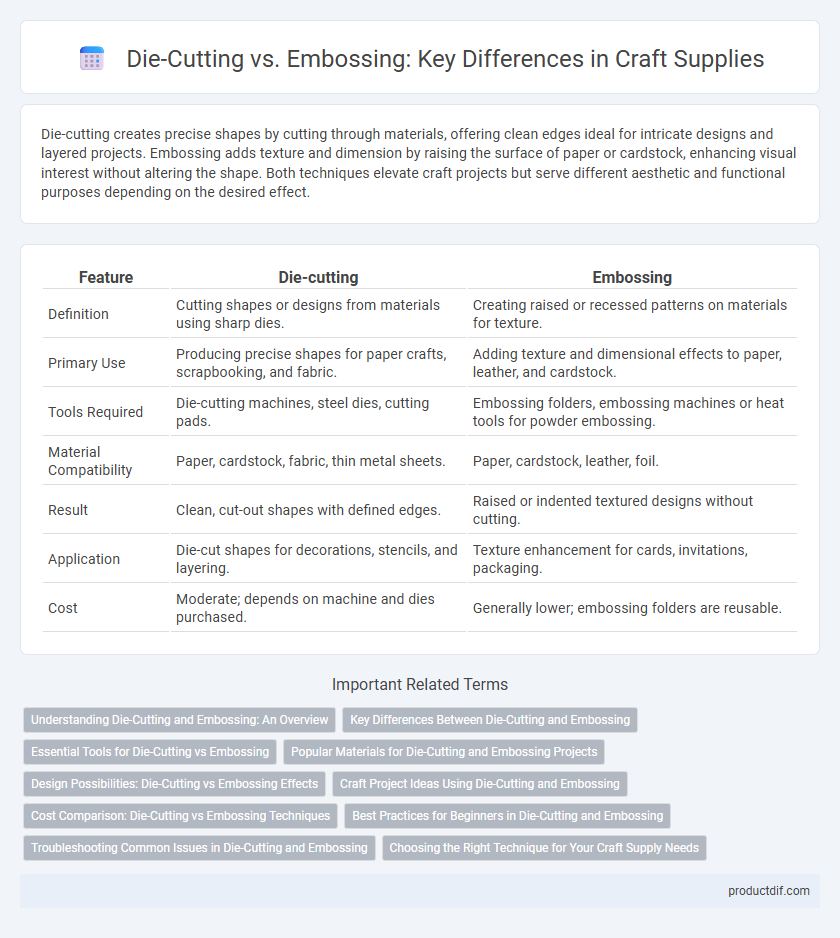Die-cutting creates precise shapes by cutting through materials, offering clean edges ideal for intricate designs and layered projects. Embossing adds texture and dimension by raising the surface of paper or cardstock, enhancing visual interest without altering the shape. Both techniques elevate craft projects but serve different aesthetic and functional purposes depending on the desired effect.
Table of Comparison
| Feature | Die-cutting | Embossing |
|---|---|---|
| Definition | Cutting shapes or designs from materials using sharp dies. | Creating raised or recessed patterns on materials for texture. |
| Primary Use | Producing precise shapes for paper crafts, scrapbooking, and fabric. | Adding texture and dimensional effects to paper, leather, and cardstock. |
| Tools Required | Die-cutting machines, steel dies, cutting pads. | Embossing folders, embossing machines or heat tools for powder embossing. |
| Material Compatibility | Paper, cardstock, fabric, thin metal sheets. | Paper, cardstock, leather, foil. |
| Result | Clean, cut-out shapes with defined edges. | Raised or indented textured designs without cutting. |
| Application | Die-cut shapes for decorations, stencils, and layering. | Texture enhancement for cards, invitations, packaging. |
| Cost | Moderate; depends on machine and dies purchased. | Generally lower; embossing folders are reusable. |
Understanding Die-Cutting and Embossing: An Overview
Die-cutting uses sharp metal dies to cut precise shapes from materials like paper, fabric, and vinyl, allowing for intricate designs and consistent replication. Embossing creates raised or recessed textures on a surface by pressing a design into the material, enhancing tactile appeal and visual depth without cutting. Both techniques are essential in craft supply projects, offering unique creative possibilities for scrapbooking, card making, and decorative accents.
Key Differences Between Die-Cutting and Embossing
Die-cutting involves cutting shapes from materials using a sharp steel blade, creating precise, customizable cuts ideal for intricate designs and patterns. Embossing, on the other hand, raises or debosses the surface of the material, adding texture and dimension without cutting through the substrate. Key differences include die-cutting's focus on shape removal versus embossing's creation of tactile surfaces, each enhancing craft projects in unique ways.
Essential Tools for Die-Cutting vs Embossing
Essential tools for die-cutting include metal dies, a die-cutting machine such as a manual or electronic press, and cutting plates to shape materials precisely. Embossing requires embossing folders, an embossing machine or heat tool, and specialty papers to create raised or recessed designs. Both techniques benefit from high-quality cardstock, but die-cutting emphasizes cutting accuracy while embossing focuses on texture and dimension.
Popular Materials for Die-Cutting and Embossing Projects
Popular materials for die-cutting include paper, cardstock, fabric, and thin metal sheets, chosen for their ease of cutting and ability to hold intricate shapes. Embossing commonly uses thicker cardstock, leather, and metallic foils to create raised textures and detailed designs. Both techniques favor materials that respond well to pressure and retain fine details, enhancing the visual and tactile appeal of craft projects.
Design Possibilities: Die-Cutting vs Embossing Effects
Die-cutting enables precise shapes and intricate patterns by cutting through paper and other materials, offering extensive design versatility for crafting projects. Embossing creates raised or recessed textures that add tactile depth and visual interest without altering the material's shape. Combining die-cutting with embossing techniques expands creative potential, allowing crafters to produce multi-dimensional effects and elaborate details in cards, scrapbooks, and mixed media art.
Craft Project Ideas Using Die-Cutting and Embossing
Craft project ideas using die-cutting include creating intricate paper shapes, personalized scrapbook embellishments, and custom greeting cards with precise cutouts. Embossing techniques enhance projects by adding texture and dimension to invitations, gift tags, and decorative stationery. Combining die-cutting and embossing in craft supplies elevates handmade designs with detailed patterns and raised effects for professional-quality results.
Cost Comparison: Die-Cutting vs Embossing Techniques
Die-cutting generally incurs higher initial costs due to the need for custom metal dies, making it more suitable for large production runs where cost per unit decreases significantly. Embossing requires less expensive tooling and is often more cost-effective for smaller batches or one-off projects. Factoring in setup time and material waste, die-cutting offers precision and repeatability, while embossing provides a textured finish at a lower upfront expense.
Best Practices for Beginners in Die-Cutting and Embossing
For beginners in die-cutting and embossing, selecting the right materials such as cardstock or thin metallic sheets ensures clean cuts and crisp embossing details. Using a quality die-cutting machine with adjustable pressure settings helps achieve precise shapes without damaging the material. Experimenting with layering techniques and applying gentle, consistent pressure produces the best results in both die-cutting and embossing projects.
Troubleshooting Common Issues in Die-Cutting and Embossing
Troubleshooting common issues in die-cutting involves checking blade sharpness and adjusting pressure settings to avoid incomplete cuts or torn materials. Embossing problems often stem from incorrect sandwich layering or insufficient pressure, causing weak or uneven impressions. Ensuring proper alignment and using compatible materials can significantly improve the quality of die-cut and embossed craft projects.
Choosing the Right Technique for Your Craft Supply Needs
Die-cutting uses precision blades to create intricate shapes and patterns from materials like paper, vinyl, or fabric, ideal for detailed decorative elements. Embossing raises designs on the surface of paper or cardstock, adding texture and dimension that enhances visual interest and tactile appeal. Selecting between die-cutting and embossing depends on whether your craft project requires precise cutouts or textured embellishments for a professional finish.
Die-cutting vs Embossing Infographic

 productdif.com
productdif.com